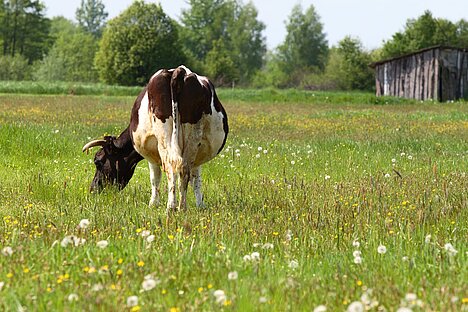Beef tail

You may have heard of beef tail as dog food or even tried it. But what exactly is beef tail and what are the advantages and disadvantages for your four-legged friend? In this article, you'll find out everything you need to know about this ingredient.
What is a cattle tail?
Beef tail is, as the name suggests, the tail of the cow. It consists of muscle meat, cartilage, tendons and bones and has a high proportion of connective tissue. Beef tail is often used as soup meat, as it gives off a lot of flavor and gelatin. However, it can also be used as dog food, either raw or cooked.
What are the benefits of beef tail for dogs?
Beef tail has several benefits for dogs that you should be aware of. Firstly, it is a good source of high-quality protein, which is important for your dog's muscle development and health. Secondly, it contains many minerals such as calcium, phosphorus and magnesium, which ensure strong bones and teeth. Beef tail can also aid digestion as it provides a lot of fiber. Last but not least, beef tail can also serve as a chew that is fun for your dog and exercises his chewing muscles.
What are the disadvantages of beef tail for dogs?
However, beef tail also has some disadvantages for dogs that you should not ignore. For one thing, it is very high in fat, which can lead to obesity and health problems. Secondly, it can contain bone or cartilage splinters that can harm your dog. These can lead to injuries in the mouth or digestive tract or even cause an intestinal blockage. Beef tail can also contain bacteria or parasites that can cause infection in your dog. Therefore, you should always wash and cook beef tail well or only buy it from trustworthy sources.
How do you feed beef tails to dogs?
If you want to feed your dog beef tail, there are a few things you should bear in mind. Firstly, you should always pay attention to the quality and origin of the meat. Only buy fresh or frozen beef tail from a butcher or a specialist dog food store. Secondly, you should always pay attention to the quantity and frequency. Do not feed your dog more than 10% of its daily energy requirement of beef tail and not more than once a week. Thirdly, you should always pay attention to the preparation. Cut the beef tail into small pieces and cook it thoroughly or add it raw to the bowl. Make sure that there are no bone or cartilage splinters in the meat and remove them if necessary.
Beef tail is an interesting ingredient for dogs that has some advantages but also some disadvantages. You should inform yourself well before feeding your dog beef tail and always pay attention to the quality, quantity and preparation.
If you notice any signs of hypersensitivity or poisoning in your dog, you should see your vet immediately. We are not a substitute for a vet, but we try to be as accurate as possible. Every dog reacts differently and we recommend you get a second opinion or consult your vet if in doubt.
Stay healthy and take good care of your four-legged friend!😊
Similar to Beef tail
Buffalo tail is a part of the tail of buffalo, which live mainly in Asia, Africa and North America. Buffalo are large, strong animals that belong to the cattle family. Their tails are long and bushy...
Lamb's tail is the tail of a lamb, which is usually cut off before the animal is slaughtered. It consists of cartilage, bone, fat and skin and is around 10 to 15 centimetres long. Lamb tail is rich...
Sheep's tail is the tail of a sheep, which is usually dried or smoked to preserve it. It consists of cartilage, bone, fat and fur and has an intense smell and taste that attracts many dogs. Sheep's...
The goat's tail is a part of the goat's skeleton that consists of cartilage and bone. It is usually around 20 to 30 cm long and has a curved shape. It can be offered with or without fur. Goat's tail...



